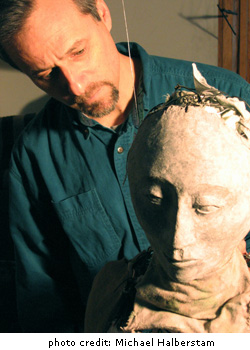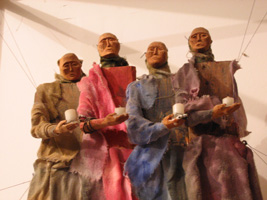
It might be surprising that an artist so universally acclaimed could have hidden his light under a bushel for more than a decade. But self-promotion is not a skill of the self-effacing Montenegro. Furthermore, it is only recently that Chicago’s mainstream theatre has incorporated puppetry into its theatrical vocabulary. Maybe it’s happening now, as Montenegro suggests, because the Sesame Street generation has joined the ranks of theatre patrons. Or maybe it’s just the vagaries of theatrical fashion.
 What is clear is that Montenegro has become one of the first artists you turn to if you want puppets. As Mary Zimmerman puts it, “he’s the known senior practitioner of puppetry in the city.” Zimmerman worked with Montenegro to realize some of the fantastical characters in her production of Argonautika. She notes that her collaboration with Montenegro marked the first time she had incorporated the vision of a “co-craftsman” into her work. “I’ve staged fantastical things before, but this time I wanted the stage pictures to be more complete, I wanted some of these objects to be actually built. So I thought, instead of relying on my own abilities, I would enlist the help of someone who has that experience and skill. My imagination only goes so far; I knew Michael’s imagination would add something.” Among the progeny of that imaginative collaboration, Zimmerman’s favorites include Montenegro’s harpies, a boxer, and a baby who dies most hearbreakingly by having its strings cut.
What is clear is that Montenegro has become one of the first artists you turn to if you want puppets. As Mary Zimmerman puts it, “he’s the known senior practitioner of puppetry in the city.” Zimmerman worked with Montenegro to realize some of the fantastical characters in her production of Argonautika. She notes that her collaboration with Montenegro marked the first time she had incorporated the vision of a “co-craftsman” into her work. “I’ve staged fantastical things before, but this time I wanted the stage pictures to be more complete, I wanted some of these objects to be actually built. So I thought, instead of relying on my own abilities, I would enlist the help of someone who has that experience and skill. My imagination only goes so far; I knew Michael’s imagination would add something.” Among the progeny of that imaginative collaboration, Zimmerman’s favorites include Montenegro’s harpies, a boxer, and a baby who dies most hearbreakingly by having its strings cut.


Montenegro’s work succeeds, says Zimmerman, “because it tells just enough, and then lets the viewer fill in the rest. It’s suggestive in the most accurate way.” Another great Chicago puppeteer, Blair Thomas, characterizes Montenegro’s work similarly. According to Thomas (who is one of the founders of Red Moon Theatre and the creator of the beautiful puppets in Frank Galati’s recent production of The Snow Queen at Victory Gardens), “It’s an asset in puppet theatre when the work is successfully distilled -- when something complex is made simple. Michael can do that, and the result is that his work is haunting.”



Thomas also notes that Montenegro’s style is strongly influenced by his work as a sculptor and painter. “He works in fine arts, too, and he understands textures of fabrics, the qualities of wood and paint, what they communicate separate from their sculptural qualities. He’s not afraid to expose the qualities of his materials with great results.” Montenegro himself calls his puppets “kinetic sculptures.”



Not surprisingly, the precise eloquence of Montenegro’s work comes at a cost. Zimmerman recounts how Montenegro became increasingly anxious over the course of rehearsals for Argonautika. “He’s just the world’s nicest guy. But he’s also very perfectionist, very concerned about getting everything just right. I’m more down and dirty, because everything in the theatre is contingent on everything else, you can’t control it all, you just have make do. But Michael became increasingly furrow-browed as we got close to opening. I kept saying, why is Michael so worried? From the outside, it was already 1000 times better than anyone else could do. But he just has very high standards, and probably he’s just temperamentally worried.”
 Montenegro’s temperament, sensibility and preoccupations are most evident in the little puppet theatre pieces he performs in off-beat venues -- pieces for which he is not only the puppet builder and puppeteer, but also director, writer and designer. Iktu Blas was produced at the Actors’ Gymnasium in 2001. As Montenegro describes it, “the seed of the play was the phenomenon of the dictator as an archetype, and how that type seems to resurface no matter what human beings do. And I was also trying to connect that phenomenon to the internal dictator, the person who is a dictator to us, this voice we struggle against. It lent itself to puppet theatre somehow, to work with the internal and external like this.” The piece begins with a tiny 2-inch puppet, screaming. Over the course of the piece, this figure grows and transforms, surviving every attempt to stamp him out by becoming more and more mechanical, less and less human, until he is enormous and virtually indestructible.
Montenegro’s temperament, sensibility and preoccupations are most evident in the little puppet theatre pieces he performs in off-beat venues -- pieces for which he is not only the puppet builder and puppeteer, but also director, writer and designer. Iktu Blas was produced at the Actors’ Gymnasium in 2001. As Montenegro describes it, “the seed of the play was the phenomenon of the dictator as an archetype, and how that type seems to resurface no matter what human beings do. And I was also trying to connect that phenomenon to the internal dictator, the person who is a dictator to us, this voice we struggle against. It lent itself to puppet theatre somehow, to work with the internal and external like this.” The piece begins with a tiny 2-inch puppet, screaming. Over the course of the piece, this figure grows and transforms, surviving every attempt to stamp him out by becoming more and more mechanical, less and less human, until he is enormous and virtually indestructible.

 Another piece characteristic of this body of Montenegro’s work is The Sublime Beauty of Hands, which was produced at Links Hall in early 2005. As Montenegro says, “That was based in part on my anger and dismay at the fact that people can go to work and sit down at an office desk and design weapons like cluster bombs and land mines. Somebody is carefully designing something that will take someone else’s legs off. I find that just incredible. And part of what fascinated me about that was how similar that design process is to the making of puppets.”
Another piece characteristic of this body of Montenegro’s work is The Sublime Beauty of Hands, which was produced at Links Hall in early 2005. As Montenegro says, “That was based in part on my anger and dismay at the fact that people can go to work and sit down at an office desk and design weapons like cluster bombs and land mines. Somebody is carefully designing something that will take someone else’s legs off. I find that just incredible. And part of what fascinated me about that was how similar that design process is to the making of puppets.”
Although there was virtually no press for these pieces, and not many people saw them, this is the work that Montenegro finds most fulfilling and about which he feels the most conviction. It may be, indeed, that a puppet artist -- or, at least, this particular puppet artist -- is most temperamentally suited to the fringes of the theatre establishment, where he has the most control and attracts the least attention. As Montenegro puts it, a puppeteer is like a musician who says, “don’t look at me, look at my guitar.” He is the one whose face is covered, who stands to the side or behind a curtain, while the audience’s attention is focused on an inanimate object that somehow, miraculously, comes to life.
Thomas suggests one source for that quality of the miraculous in Montenegro’s work. “The first time I met Michael, I went to his studio in Evanston. And out of the debris of his studio he pulled this marionette made entirely of rocks wired together to make a figure that could walk. That’s an impossible puppet. But impossibility is what he takes on, trying to reveal something that can’t be realized. And the exciting thing is when he gets close -- and brings us close --- to that impossibility.”
Anne Nicholson Weber
Anne@TheatreInChicago.com
Theatre in Chicago contributor Anne Nicholson Weber saw Jack and the Beanstalk at the Goodman Children’s Theatre and has loved theatre every since. She is the author of Upstaged: Making Theatre in the Media Age, which includes interviews with Tony Kushner, Julie Taymor, Maggie Gyllenhaal, Martha Lavey and Sir Peter Hall, among many others, and her work has been published in American Theatre Magazine and other national publications
